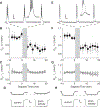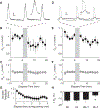Activity-dependent long-term depression of electrical synapses
- PMID: 22021860
- PMCID: PMC10921920
- DOI: 10.1126/science.1207502
Activity-dependent long-term depression of electrical synapses
Abstract
Use-dependent forms of synaptic plasticity have been extensively characterized at chemical synapses, but a relationship between natural activity and strength at electrical synapses remains elusive. The thalamic reticular nucleus (TRN), a brain area rich in gap-junctional (electrical) synapses, regulates cortical attention to the sensory surround and participates in shifts between arousal states; plasticity of electrical synapses may be a key mechanism underlying these processes. We observed long-term depression resulting from coordinated burst firing in pairs of coupled TRN neurons. Changes in gap-junctional communication were asymmetrical, indicating that regulation of connectivity depends on the direction of use. Modification of electrical synapses resulting from activity in coupled neurons is likely to be a widespread and powerful mechanism for dynamic reorganization of electrically coupled neuronal networks.
Figures




Comment in
-
Neuroscience. The strength of electrical synapses.Science. 2011 Oct 21;334(6054):315-6. doi: 10.1126/science.1213894. Science. 2011. PMID: 22021844 Free PMC article. No abstract available.
-
Synaptic plasticity: tuning electrical synapses.Nat Rev Neurosci. 2011 Nov 9;12(12):705. doi: 10.1038/nrn3142. Nat Rev Neurosci. 2011. PMID: 22068693 No abstract available.
References
Publication types
MeSH terms
Substances
Grants and funding
LinkOut - more resources
Full Text Sources
Other Literature Sources
Miscellaneous

